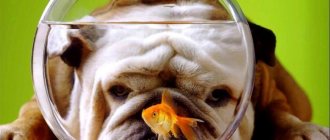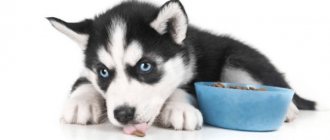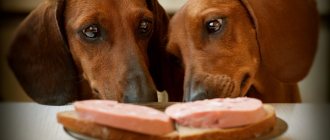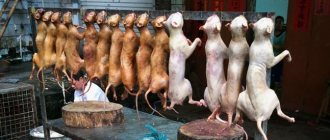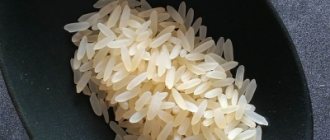If you are preparing to buy a husky puppy, you are probably wondering: what to feed him? The problem is that it is very difficult for novice owners to make a decision, because there are hundreds of manufacturers of ready-made food on the market. You also need to choose food on which your dog’s healthy functioning will depend. In this article you will learn about all the intricacies of feeding a husky, find out when and how to do it correctly and, ultimately, get rid of this problem.
This wonderful breed, bred from aboriginal dogs, was intended for riding, so its distinctive features are speed, great performance, strength and endurance. However, due to their loyalty and friendliness, today they like to keep huskies in apartments, as a pet and companion. And since these dogs differ in many ways from other breeds, special attention must be paid to their feeding.
Nutrition
Nutrition plays a big role in the growth and development of a puppy . In childhood, the formation of the musculoskeletal system and the formation of muscles occurs, and specialized feeding affects:
- dental condition;
- gums;
- joints;
- improved digestion;
- maintaining immunity;
- work of the central nervous system.
Food must be nutritious and contain all the necessary vitamins, minerals, micro and macroelements.
Before you start feeding the animal, you must decide on the method of feeding it. There are 2 types:
- natural;
- ready-made (purchased) food.
Natural food or artificial food?
The owner of a husky puppy must decide what he will feed the pet: natural products or ready-made factory-made food. You cannot combine two types of food.
During heat treatment, partial breakdown of nutritional components occurs, that is, the initial stage of digestion has already occurred. And natural products need to be digested from scratch. This feed mixture disrupts the work of enzymes, causing digestive upset.
Natural diet
Every person wants to see their dog healthy, active and cheerful, and these factors largely depend on proper nutrition. Consequently, most people are confident in the absolute usefulness of natural food, because they can track what exactly goes into their dog’s body, but they do not trust store-bought food. However, this approach is erroneous, since this diet may not always be balanced.
You should know that the metabolism of the Siberian husky, like that of wolves, is protein-fat, and not protein-carbohydrate.
The advantages of natural food include:
- has no harmful additives;
- contains a sufficient amount of fiber and protein;
- the choice and quality of products are intended for the owner.
Minuses:
- takes a significant amount of time;
- difficulties with switching to another food;
- unbalanced diet.
To ensure a balanced diet, follow the percentage ratio.
General rules
- 50 – 70% of all food is meat.
- 10 – 20% of all food is cereals.
- 20 - 30% of all food is vegetables.
- 10–20% of all food is dairy products.
Main Products
- Meat . Low-fat varieties are best - chicken, turkey, beef, venison. But pork and lamb should be avoided. Boiled meat with cartilage and films will bring great benefits to the dog’s body.
- Offal . Sometimes they can be an excellent substitute for meat, or add variety to the protein diet. These are the scar, liver, heart, lung, trachea, spleen and kidneys.
- Fish . Red sea fish (trout, char, salmon, etc.) are suitable as an additional source of protein and essential amino acids. The benefits of fish cannot be overestimated, because its protein is easily digestible, and the product itself contains a large amount of vitamins (A, B1, B2, B3, B6, B9, B12, C, D, E) and minerals (potassium, phosphorus, sulfur, chlorine, sodium, magnesium, calcium, iodine, zinc, iron, fluorine). Thanks to this composition, the dog’s thyroid function is normalized, metabolic processes, memory and attention are improved, which is important when training and teaching commands. Essential amino acids contained in it, such as arginine, tryptophan, methionine, leucine, valine, lysine, threonine, have an antioxidant effect, and the presence of hyaluronic acid and collagen is excellent for the health of the pet’s ligaments and cartilage.
- Eggs . It is allowed to give both quail (2 - 3 pieces) and chicken (boiled or raw).
- Vegetables, boiled, or with the addition of vegetable oil . Necessary micro and macroelements are found in zucchini, pumpkin, cabbage, cucumbers, carrots and beans.
- Fruits . Many pets cannot live without fruit. Pamper them with small portions of banana, apple, pear and tangerine slices.
- Fermented milk products . The basis for the musculoskeletal system is low-fat fermented milk products - cottage cheese, kefir. However, they must be absolutely fresh.
- Cereals . To prepare porridge, you need to use only three types of cereals: oatmeal, rice and buckwheat. They contain fiber and dietary fiber, which affect the smooth functioning of the intestines.
“Remember, obesity is a dangerous disease that has critical consequences. Periodically feel your dog’s ribs and monitor his weight.”
Nutritional supplements
After consulting with your veterinarian in advance, you can add the following supplements::
- Brewer's yeast;
- bone flour;
- fish fat;
- calcium tablets.
Vitamins and supplements
Feeding huskies with natural products requires the mandatory introduction of vitamins and mineral supplements into the diet. Of the latter, the most important are:
- potassium,
- phosphorus;
- calcium;
- sodium.
The finished complex, purchased at a veterinary pharmacy, must also contain:
- Vitamin A. Necessary for normal kidney function, improved vision, and stimulation of the immune system.
- Group B. Ensures the growth of the animal and has a beneficial effect on the coat.
- Ascorbic acid. Promotes calcium absorption.
- Vitamin D. Prevents rickets.
- Vitamin E. Necessary for the full functioning of the heart muscle, maintains hormonal balance, improves the absorption of fats.
Ready food
Store-bought food consists of canned food and dry granules.
Advantages of ready-made food:
- quick cooking;
- contains all the necessary substances;
- ease of use and transportation;
- developed menu.
Disadvantages include::
- lack of moisture;
- difficulties in selection;
- expensive;
- presence of preservatives;
- inability to provide natural products.
Attention! It is strictly forbidden to mix natural food with prepared food! These are too different types of food.
What to feed a husky puppy for 1 month at home: basic rules
From an early age, the pet must be accustomed to a certain type of food: prepared or natural.
Mixed feeding is absolutely not suitable and can lead to gastrointestinal diseases. Another important rule is to eat strictly after a walk. Representatives of this breed are extremely active; walking with them on a full stomach can cause intestinal volvulus and death of the animal. Pros of a natural diet:
- No harmful substances;
- Sufficient protein and fiber content;
- It is easy to control the quality of components.
Minuses:
- Requires time investment;
- It is not easy to switch to another food if necessary;
- It's difficult to balance the ratio of ingredients on your own.
Advantages of ready-made food:
- Ideally selected components;
- No need to cook;
- Easy to take on the go.
Minuses:
- It is necessary to closely monitor that the dog receives water, which is not present in dry (freeze-dried) food;
- It is difficult to select components for the individual needs of a pet;
- The composition may contain harmful substances;
- The price is often inflated;
- Natural feeding is excluded.
It is important to remember that even if the natural type is chosen, feeding “from your plate” is unacceptable. The calorie content of human food is overestimated, and in addition, it is not balanced to suit the digestive characteristics of the animal. There is no consensus on which food is more suitable, wet (canned) or freeze-dried, but the second type is still preferable.
Can I feed dry food?
As mentioned above, the choice of food is yours, but it also depends on the dog. Watch your husky and see what he likes to eat more - dry food or home-made natural products. There are individuals with individual intolerance to one of the feeding methods . Some cannot eat ready-made food - they immediately begin to have digestive problems and diarrhea, while others, on the contrary, have a similar reaction to natural food.
Make sure there is fresh water in the bowl! Especially when feeding dry food, the dog should always have enough drinking water.
Pet stores will provide you with a wide range of dry food manufacturers. In this case, the price directly depends on the quality.
Buy premium and super-premium food:
- Particularly inexpensive of them, and corresponding to average good quality, are Pro Plan, Royal Canin.
- Higher level – Eukanuba, Hills, Acana, Orijen.
At what age is it better to start and what is the best age?
Let's figure out what to feed puppies 1 month or older. In any food, regardless of the brand, there are age ranges :
- For puppies from 3 weeks to 2 months and pregnant bitches – STARTER.
- For puppies from 2 to 10 months – PUPPY.
- For dogs from 8 months to 2 years – JUNIOR.
- For dogs from 1 to 6 years old – ADULT.
- For dogs over 6 years old - food with the wording “for older dogs”.
Features of the Husky breed
Husky is a native, working dog breed bred to carry small loads over long distances. The history of the breed is shrouded in fog, but there is an assumption that the ancestors of the husky are polar wolves. Modern representatives of the breed are practically not used for working purposes and are considered as show class dogs.
The characteristics of the breed make a husky a natural disaster if a puppy is purchased only for appearance or fashion. Huskies are very active, often run away, and require careful and labor-intensive care. Training a Husky requires some experience or the help of a professional.
Diet by month
- Up to 2 months – 6 times a day.
- From 2 months – 4-5 times a day.
- From 4 months up to six months – 3 times a day.
- From six months to one year – 2-3 times a day.
- From a year - 1-2 times a day.
Sample menu for a day at 2 months
- 8.00 – 1 chicken egg or 2 quail eggs.
- 11.00 – 100 g of cottage cheese.
- 15.00 - buckwheat porridge.
- 18.00 – 150-200 g of meat or fish.
- 20.00 – vegetable salad in vegetable oil.
- 22.00 – milk or yogurt.
For dry food, you should use a measuring cup and calculate the dosage according to the age and size of your dog. Also study the information on the food packaging and listen to the breeder’s recommendations.
Remember, the volume of dry food in the dog’s stomach increases at least twice.
Veterinarian recommendations
Andrey, Moscow: “Husky dogs are prone to obesity, so you should not feed her a lot or in too large portions. If the dog has not eaten within 20 minutes, we remove the food. He doesn't eat that much per day thanks to the metabolism they got from the wolves. But this does not mean that the dog should starve - be extremely careful and responsible with its nutrition.”
Yulia, Krasnodar: “Husks are amazing animals, even when it comes to food. Despite their unusual appearance, they are not picky. But you need to strictly follow the feeding schedule and not give your dog prohibited or allergenic treats. Food from the master’s table is taboo for huskies, even small children who love to treat pets should know this.”
Vyacheslav, Sevastopol: “Blue-eyed northern dogs love not only to frolic, but also to eat deliciously, despite their unpretentiousness in food. Therefore, the owner must control the schedule and balance of nutrition, otherwise the dog will turn into a fat fluffy ball, and it will be difficult for him to even walk.”
Even in feeding, huskies remain special dogs; close attention is paid to their nutrition. The main thing is to keep it balanced and remember the prohibited foods for this breed.
Despite the strong endurance and activity of Siberian dogs, their stomach is the most vulnerable organ, so eating unwanted food can lead to serious illnesses.
Which is correct?
How many times a day?
When puppies reach 14 days of age, they begin to introduce additional complementary foods - 1-2 times a day:
- Dry granules are pre-soaked with warm water in a ratio of 1:2.
- Let them sit for about 20 minutes, the granules should swell and become soft. If necessary, you can crush them with a spoon and turn them into a paste-like mixture.
When babies turn one month old, they switch to 6 meals a day.
Daily norm
The daily feed intake depends on weight and age . See the packaging of your food for information.
How to prevent overfeeding?
Overfeeding is very dangerous, fraught with the appearance of a hernia and intestinal blockage. Monitor your pet's stool regularly and feel its tummy. Strictly adhere to feeding standards.
What can you do from porridge?
- Meat porridge (2 servings) . For 500 g of beef tenderloin, pour 1/3 cup of cereal (oatmeal, buckwheat or rice) with water and add carrots and cabbage. Bring to readiness.
- Porridge with chicken . You will need 1 kg of chicken thighs, 1/2 cup of rice, chopped onion, bay leaf. Pour water over the meat, bring to a boil, then add the rest of the ingredients. Cook until the rice is completely cooked.
- Ordinary cereal porridge . Just pour the hot broth over the flakes (buckwheat or oatmeal). 1 tsp will improve the dish. butter.
Should I give vegetables?
Raw and boiled vegetables should not be given . They are boiled - sliced various vegetables are poured with boiling water for several minutes. Don't forget that steaming is also very suitable. Steamed food is good for digestion, and when choosing this method of heat treatment, it retains a maximum of minerals and vitamins. Only fresh tomatoes and cucumbers can be given raw.
Should I give milk?
From the 20th day you can give the puppy milk, use cow or goat milk. There are times when it disappears in a nursing bitch, then add a fresh chicken egg to the milk of your choice, at the rate of 1 pc. by 0.5 liters.
After 3 months, you can safely switch to cottage cheese and fermented milk products.
Recipes
It is recommended to feed Husky puppies the following foods:
- Porridge with meat. For two servings you need to take 600 g of beef, a third of a glass of cereal (rice or buckwheat). Fill with water and place on the stove. Carrots, cabbage, zucchini and a pinch of salt are added to the boiling porridge. It is prohibited to use seasonings to feed your husky.
- Chicken porridge. For 4 servings you need a kilogram of legs. They are filled with water and cooked until half cooked. Add finely chopped carrots, half a glass of rice, and onions.
- Oatmeal. Pour in hot broth and leave for 30 minutes. Season with butter or sunflower oil.
- Curd with calcium. Add three tablespoons of 10% calcium chloride to a liter of milk. After boiling, strain through cheesecloth or a sieve. Cottage cheese is given to a husky puppy warm.
List of prohibited products
- Fish, tubular bones.
- Ground meat.
- Pork.
- Spices, spices, seasonings.
- Legumes.
- Bread and other flour products.
- Smoked meats.
- Salt.
- Pickled, spicy food.
- Roast.
- Chocolate, sugar, sweets, candy.
- Raisin.
- Grape.
- Apricots.
- Potato.
- Honey.
- Nutmeg.
- Alcohol.
- Coffee.
The arrival of a Siberian Husky puppy in your home is a wonderful event. For your pet to be active and healthy, it needs proper care and nutrition. Using this information, you will not have problems with your puppy's nutrition, and your pet will be happy and cheerful for many years.
Feeding frequency for a one-month-old Haskm puppy
The amount of food is calculated based on individual needs, but usually such dogs are not prone to overeating. Feeding should occur in 4-5 doses. Obesity is not typical for the breed; this condition puts a strain on the cardiovascular system and often causes pancreatitis and fatty liver. You should not allow yourself to gain excess weight, but you should not allow yourself to become exhausted either. Normally, the spine and rib bones are not felt when stroking.
These puppies are wonderful companions, and yet one must take into account the fact that their oldest breed is, first of all, a sled dog. They need physical activity and a high-quality diet that takes into account all their needs. If the food is chosen incorrectly, there is a high probability of health problems in the future.
From 8 weeks
By this time, the digestive system has time not only to form, but also to get stronger. Puppies can start giving offal. But you also need to choose them carefully. For example, the puppy will swallow chicken necks, but will gnaw on the backs. Tripe can also be given in the proportions recommended for adult animals. The frequency of feedings is now gradually decreasing, but the portion is increasing.
A baby at this age eats as much as an adult dog of the same breed, if you take the daily amount of food. Males always eat more than females. For normal digestion, you must add chopped fresh herbs. By this age, the number of feedings per day is reduced to three, but the diet should still include fermented milk products.
Basic knowledge
The average fat content of a bitch's milk is 9-10%. The substitutes you choose should have exactly the same fat content or slightly less. Often, owners make a common mistake and start feeding their puppies too early. Often this is not necessary. If the puppies sleep most of the time and gain weight normally, then everything is fine and there is no need to get up at night with the intention of bottle-feeding them. Don't forget that a bitch produces as much milk as her puppies drink. That is, with supplementary feeding you will stimulate a decrease in its amount.

